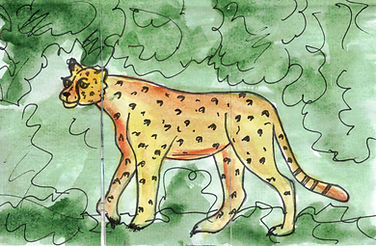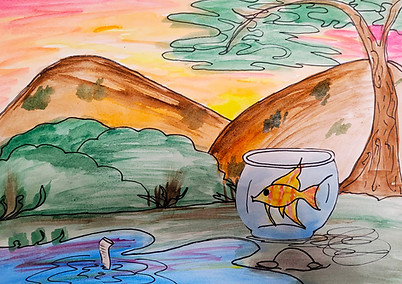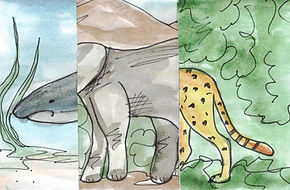Animal Drawing
Mix-Up
Let's Mix It Up!
We're all used to seeing images of wild animals in their natural habitats. But what would it look like if you shook up the planet like a snow globe, and the entire animal kingdom was shuffled out of its natural order? In this lesson, you will use your imagination, and a bit of artistic license, to create and render a drawing that demonstrates a silly scenario for two opposite animals who've been flip flop into each others' habitat!

Materials You'll Need:
-
4 sheets of 8.5" x 11" paper (one sheet is a scrap paper for experimenting with color mixing, blending, and practice sketching).
-
pencil, black Sharpie, eraser, paintbrush
-
colored drawing medium: colored pencils, crayon, markers, watercolor, etc. (Pro tip: brushing a little bit of water over washable marker makes the ink spread like watercolor paint! Just be sure to practice this technique on your scrap paper before applying it to your final picture.)
-
scissors
-
adhesive: glue/glue stick, tape
-
reference images from magazines, books, google images, Pinterest, etc.
**Pro Tips: Love the look of watercolor or Sharpie but don't have them on hand? No problem! Improvisation is how artists discover new techniques!
-
DIY watercolor: brushing a little bit of water over washable marker dilutes the ink and makes it spread like watercolor paint!
-
Sharpie substitute: Any pen with black ink, or black colored pencil will do! Check if ink is water-soluble first! If it is, then make sure to use it to outline your drawing AFTER applying wet medium.
-
Just be sure to practice new techniques on your scrap paper before applying them to your final picture.
Step-by-Step Instructions:
Step 1:
-
Pick two animals, preferably of different sizes and species. Research each animal and closely examine what they look like and what their habitats are like. Refer to the attached resources below for inspiration.
-
Ask yourself, "what details stand out the most?" Does it have feathers, fur, or scales? How do they move around? Does it fly, swim, jump, climb trees? Pay attention to the colors and textures of the animals' bodies.
-
Where do they live? What survival skills do they have? What do they eat?
-
Choosing animals that live in completely opposite climates or habitats will help make a more dynamic visual. The more contrast, the better!


Step 2:
-
On two separate sheets of paper, sketch each habitat with pencil.
-
With black Sharpie, outline all pencil lines, then erase any leftover pencil markings.
-
Color with medium of your choice (watercolor was used for example).
-
Make sure to include trees, plants, bodies of water, hills, mountains, volcanoes, icebergs, and perhaps other animals native to the environment of each chosen animal. Include as many colors as you can into your pieces to show the different environmental aspects and to add texture. Be creative! The more detail, the better!




Step 3:
Now it's time to draw the animals! Make sure to consider how each animal would have to adapt in order to survive in the other animal's habitat. How would a land mammal survive under water where a fish lives, and vice versa? Use your imagination to draw a creative solution.
-
On a new sheet of paper, sketch your two chosen animals in pencil.
-
With black Sharpie, outline all pencil lines, then erase any leftover pencil markings.
-
Color with medium of your choice (watercolor was used for the example).

Step 4:
Cut out each animal.
-
Make sure that any wet medium has completely dried before cutting!

Step 5:
Time for the animals to migrate! In the two examples below, the placement of the animal cutouts depict how they've adapted for survival in their new habitats. If you look closely, you'll see how the elephant's trunk creates a connection between the two drawings!
-
Place each animal cutout on its opposite habitat drawing. Move animal cutout around until you find a placement you like. Make any necessary modifications to your animal cutouts, then secure them with glue or tape.


Optional Project Modifications:
-
Once your animals are taped or glued into place, put a cartoonish spin on your drawing by using your imagination to show your animal doing something silly, like skateboarding or eating pizza. Use construction paper, colored scrap paper, or magazine/newspaper pictures, to craft the details, and then cut and stick them onto your drawing!
-
Using a cardboard shoe box and other materials, build two 3D animal habitats of each animal’s natural habitat. Cut out animals and glue to popsicle sticks.
BONUS PROJECT:
-
Take stack of 5 sheets of 8”x11”paper and use a ruler to draw a 1/2 inch margin along the left hand vertical edge, on the top sheet of paper.
-
Space 3 staples along the vertical edge, between the margin.
-
Cut packet into thirds, making sure not to cut past the margin. You should end up with 3 evenly sized sections of paper.
-
Rotate the packet horizontally so the stapled edge is facing upward.
-
On the first section, draw a different animal head on the front of each page.
-
On the second section, draw a different animal body on the front of each page.
-
On the third section, draw a different animal's feet on the front of each page.
-
Make sure all the animal body parts align from top to bottom on the sheets so they can connect. Color everything and then flip back the pages of each packet to mix and match the different animals parts. Voila! You've created a menagerie of mythical creatures!






Additional Learning Resources:
We hope that you had fun creating your animal mix-up drawings , and also learned some fun new facts about art techniques and animals! As you've learned, effective research can be an important part of the artistic process. It's also important that artists know how to explain their artwork. Building your vocabulary helps with both! That's why we've sprinkled key terminology throughout the lesson descriptions. As you read through the directions above, click on each keyword for its definition. Don't forget to toggle back over to the Artists' Exchange website tab! How do the keywords apply to the drawings you made? We challenge you to write a story for your drawings using the keywords!
What is a habitat?
A habitat is a place where an organism makes its home. In an animal’s habitat they can find food, water, shelter, space, and any other necessary survival needs. Animals pick a home that will meet all the environmental conditions that it needs to survive and raise its family. Check out the resources below to learn more about animal habitats around the world!
https://www.nationalgeographic.org/encyclopedia/habitat/
It's a bird. It's a plane. It's Super Peregrine!
Did you know that every spring, a mama Peregrine falcon lays her eggs in a manmade nest perched atop the iconic "Superman Building", in downtown Providence? Talk about an animal habitat mixup of SUPER proportions! The Providence Peregrine Falcon Webcam livestreams every season. Click the link below to learn more about the project. Also, make sure to watch the video below to see highlights from the 2020 spring nesting season!
